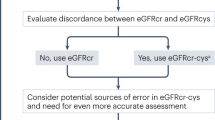Abstract
The National Center for Health Statistics estimates that more than 100,000 Americans receive chelation each year, although far fewer than 1 % of these cases are managed by medical toxicologists. Unfortunately, fatalities have been reported after inappropriate chelation use. There are currently 11 FDA-approved chelators available by prescription although chelation products may also be obtained through compounding pharmacies and directly over the internet. Promotion of chelation training is prominent on some alternative and complementary medicine websites.

Similar content being viewed by others
References
National Institutes for Health, National Center for Complementary and Alternative Medicine (NCCAM) (2010) Complementary and Alternative Medicine Newsletter. http://www.google.com/url?sa=t&rct=j&q=&esrc=s&source=web&cd=2&ved=0CDQQFjAB&url=http%3A%2F%2Fwww.wakehealth.edu%2FRecreation-Therapy%2FNational-Institute-of-Health-National-Center-for-Complimentary-and-Alternative-Medicine.htm&ei=K8jpUZq4O6qyiQKy0IGoDQ&usg=AFQjCNGW1CCMoOG0hkQWA-2T9OeGy92XfA&sig2=−ueGq0yfktHToUF3G4bBEA&bvm=bv.49478099,d.cGE. Accessed August 2013
Smith D, Strupp BJ (2013) The scientific basis for chelation: animal studies and lead chelation. JMT 9(4). doi:10.1007/s13181-013-0339-2
McKay C (2013) Role of chelation in the treatment of lead poisoning: discussion of the treatment of lead-poisoned children trial (TLC). JMT 9(4). doi:10.1007/s13181-013-0341-8
Risher JF, Amler SN (2005) Mercury exposure: evaluation and intervention the inappropriate use of chelating agents in the diagnosis and treatment of putative mercury poisoning. Neurotoxicology 26:691–699
American College of Medical Toxicology (2013) American College of Medical Toxicology conference presentations. http://www.acmt.net/2012_Use_Misuse_of_Metal_Chelation_Therapy.html. Accessed August 2013
New Jersey Department of Health and Senior Services, Agency for Toxic Substances and Disease Registry (2013) Health consultation: Franklin Township residential mercury investigation: Higgins Farm. http://www.atsdr.cdc.gov/hac/pha/HigginsFarmHC091704-NJ/HigginsFarmHC091704-NJ.pdf. Accessed August 2013
Centers for Disease Control and Prevention (2006) Deaths associated with hypocalcemia from chelation therapy—Texas, Pennsylvania, and Oregon, 2003–2005. MMWR Morb Mortal Wkly Rep 55(8):204–207
US FDA (2013) Drugs at FDA: FDA approved drug products. http://www.accessdata.fda.gov/scripts/cder/drugsatfda/index.cfm?fuseaction=Search.DrugDetails. Accessed August 2013
Peters R, Stocken L, Thompson R (1945) British anti-lewisite (BAL). Nature 156:616–619
Kosnett MJ (2013) The role of chelation in the treatment of arsenic and mercury poisoning. JMT 9(4). doi:10.1007/s13181-013-0344-5
CDC (2013) Multistate fungal meningitis outbreak investigation. http://www.cdc.gov/hai/outbreaks/meningitis-map-large.html. Accessed August 2013
Outterson K (2012) Regulating compounding pharmacies after NECC. N Engl J Med 367:1969–1972
Federal Register (1999) List of bulk drug substances that may be used in pharmacy compounding. Federal Register/vol. 64, no. 4/Thursday, January 7, 1999/Proposed Rules. http://www.gpo.gov/fdsys/pkg/FR-1999-01-07/html/99-277.htm. Accessed August 2013
Van Der Linde AA, Pillen S, Gerrits GP, Bavinck JN (2008) Stevens-Johnson syndrome in a child with chronic mercury exposure and 2,3-dimercatopropane-1-sulfonate (DMPS) therapy. Clin Toxicol 46:479–481
Amazon.com. Search results for DMSA. http://www.amazon.com/s/ref=nb_sb_noss_1?url=search-alias%3Daps&field-keywords=dmsa. Accessed July 2013
Barnes PM, Bloom B, Nahin RL (2008) Complementary and alternative medicine use among adults and children: United States, 2007. National Health Statistics Report, December 10, 2008. http://nccam.nih.gov/sites/nccam.nih.gov/files/news/nhsr12.pdf. Accessed August 2013
Bronstein AC, Spyker DA, Cantilena LR Jr, Green JL, Rumack BH, Heard SE et al (2007) Annual report of the American Association of Poison Control Centers' National Poison Data System (NPDS): 25th annual report. Clin Toxicol 46:927–1057
Wiegand TJ, Wax PM, Hart K, Smith E, Brent J, Toxicology Investigators Consortium Case Registry Investigators (2012) The toxicology investigators consortium case registry—the 2012 experience. J Med Toxicol 8:360–77
NCCAM (2013) Complementary, alternative, or integrative health: what's in a name? http://nccam.nih.gov/health/whatiscam. Accessed August 2013
Institute of Medicine (US) (2005) Committee on the Use of Complementary and Alternative Medicine by the American Public. Complementary and alternative medicine in the United States. National Academies Press, Washington DC
ACAM (2013) ACAM homepage. http://www.acamnet.org/site/c.ltJWJ4MPIwE/b.6805203/k.BD39/Detoxification__IV_Chelation.htm. Accessed August 2013
American Board of Clinical Metal Toxicology (2013) Homepage. http://abcmt.org. Accessed August 2013
Conflict of Interest
The ACMT/ATSDR Cooperative Agreement provided grant funds to Dr. Wax and/or to ACMT for support of the chelation conference, for speaker honorarium, for travel reimbursement, and for editorial assistance.
Author information
Authors and Affiliations
Corresponding author
Additional information
ATSDR Disclaimer
This publication was supported by the cooperative agreement award number 1U61TS000117-04 from the Agency for Toxic Substances and Disease Registry (ATSDR). Its contents are the responsibility of the authors and do not necessarily represent the official views of the Agency for Toxic Substances and Disease Registry (ATSDR).
Rights and permissions
About this article
Cite this article
Wax, P.M. Current Use of Chelation in American Health Care. J. Med. Toxicol. 9, 303–307 (2013). https://doi.org/10.1007/s13181-013-0347-2
Published:
Issue Date:
DOI: https://doi.org/10.1007/s13181-013-0347-2




